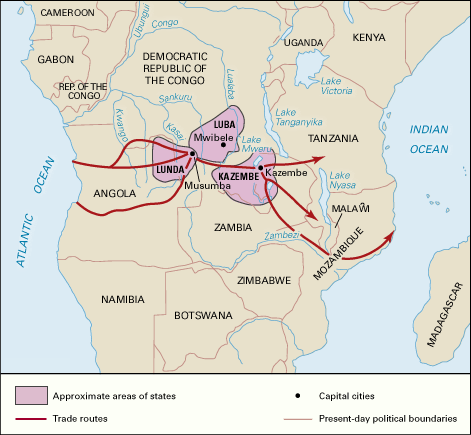The Luba-Lunda states, in what is now the southeast of the Democratic Republic of the Congo in Central Africa, were a network of kingdoms that lasted from the 15th to the 19th centuries c.e.
The Luba culture had emerged a millennium earlier, a civilization that soon began working in iron and dam construction. The local conditions—marshy wetlands that required drainage and provided a surplus of fish—encouraged large, stable communities and communal labor over individual self-sufficiency.
In time, trade relations and intermarriages between smaller communities led to a unified Luba state around the end of the 15th century c.e., by which time the Luba people were widely respected for the sophistication of their art and the quality of their ironwork, especially their axes and spears.
  |
Luba kings ruled by right of descent from Kalala Ilunga, a mythic cultural hero who had invented much of Luba culture. The Luba king was the head of a large hierarchy of officials at the state and local levels, who paid him tribute he redistributed as rewards for loyalty.
Prominent in this hierarchy were the Bambudye, the “memory men” (though women were included) who maintained oral histories of the Luba kings and their deeds. As the Egyptian pharaohs and rulers in much of the ancient and antique world, Luba kings were revered as deities upon death, and these oral histories are comparable to Christian “saints’ lives” and other religious biographies.
The Luba system of divine kingship spread to other nearby cultures, notably including the Lunda, a strong military force in the region who increased their power by intermarrying their royal family with the Luba’s and colonizing large parts of central Africa before European colonization arrested their expansion.
The Luba kingdom itself extended its power and resources to include not only the copper mines of communities who had once been only trade partners, but New World goods from the Portuguese colonists (in exchange for ivory and slaves, among other commodities), leading to a centuries-long period of growth. The Lunda continued to self-govern, though were closely aligned with the Luba; they soon controlled much of the copper trade.
By the end of the 19th century, the Luba and Lunda states were in decline. Prosperity and intermarriage had encouraged infighting in periods when royal succession was not clear-cut; neighboring tribes had acquired firearms, a significant military advantage to which neither the Luba nor the militarily superior Lunda had any recourse except to acquire guns of their own, which they did by devoting more efforts to the slave trade.
But the slave trade itself was dwindling, and this proved not only disruptive to the economy and political balance, but also ultimately ineffective. Belgian colonists took control over the region, which King Leopold II called the Congo Free State.
The Luba rebelled several times, but fruitlessly, and many were sent into forced labor in the copper mines. The Luba and Lunda (and their other client tribes) persist today as ethnic groups, but their culture has been absorbed into that of the Democratic Republic of the Congo.
